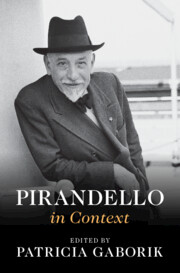Book contents
- Pirandello in Context
- Pirandello in Context
- Copyright page
- Dedication
- Contents
- Figures
- Contributors
- Preface
- Acknowledgments
- Chronology
- List of Cited Titles in Translation and the Original Italian
- Part I Places
- Part II Institutions
- Chapter 7 Publishing
- Chapter 8 Little Theatres
- Chapter 9 National Theatres
- Chapter 10 The Royal Italian Academy
- Part III Interlocutors
- Part IV Traditions and Trends, Techniques and Forms
- Part V Culture and Society
- Part VI Reception and Legacy
- Further Reading
- Index
Chapter 9 - National Theatres
from Part II - Institutions
Published online by Cambridge University Press: 14 March 2024
- Pirandello in Context
- Pirandello in Context
- Copyright page
- Dedication
- Contents
- Figures
- Contributors
- Preface
- Acknowledgments
- Chronology
- List of Cited Titles in Translation and the Original Italian
- Part I Places
- Part II Institutions
- Chapter 7 Publishing
- Chapter 8 Little Theatres
- Chapter 9 National Theatres
- Chapter 10 The Royal Italian Academy
- Part III Interlocutors
- Part IV Traditions and Trends, Techniques and Forms
- Part V Culture and Society
- Part VI Reception and Legacy
- Further Reading
- Index
Summary
The chapter considers Pirandello’s unsuccessful attempts to establish a national theatre in Italy. Influenced by examples of national theatres in other countries such as the Comédie Française in France and disappointed with the lack of financial resources to sustain his own very successful Teatro d’Arte, Pirandello tried to use Mussolini’s influence and the rise of Fascism to create a national theatre run by himself with full state sponsorship. He developed elaborate plans for a national theatre that would operate in three major cities and house ensemble casts, some of whose members would travel between the cities to facilitate touring productions. The plans would have involved considerable expenditure, including the costs of establishing the technical infrastructure for the three theatres as well as of maintaining three ensembles of actors. Despite initial encouragement and support from Mussolini, Pirandello encountered competition from other entrepreneurs and artists and political opposition, and eventually failed to achieve his goal.
- Type
- Chapter
- Information
- Pirandello in Context , pp. 69 - 76Publisher: Cambridge University PressPrint publication year: 2024

